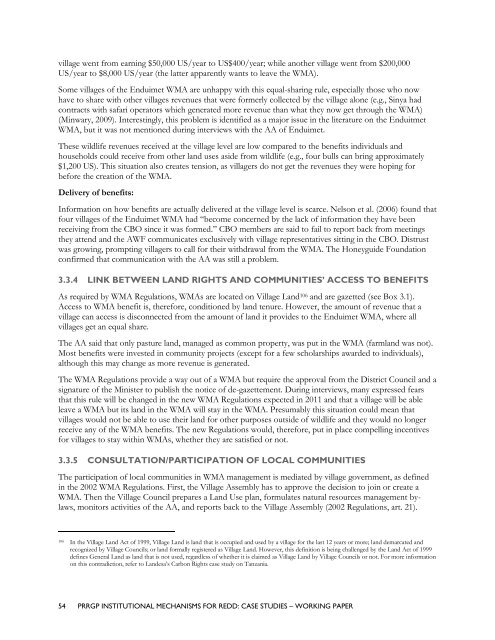Institutional Mechanisms for REDD+ - Case Studies Working Paper
Institutional Mechanisms for REDD+ - Case Studies Working Paper
Institutional Mechanisms for REDD+ - Case Studies Working Paper
You also want an ePaper? Increase the reach of your titles
YUMPU automatically turns print PDFs into web optimized ePapers that Google loves.
village went from earning $50,000 US/year to US$400/year; while another village went from $200,000<br />
US/year to $8,000 US/year (the latter apparently wants to leave the WMA).<br />
Some villages of the Enduimet WMA are unhappy with this equal-sharing rule, especially those who now<br />
have to share with other villages revenues that were <strong>for</strong>merly collected by the village alone (e.g., Sinya had<br />
contracts with safari operators which generated more revenue than what they now get through the WMA)<br />
(Minwary, 2009). Interestingly, this problem is identified as a major issue in the literature on the Enduitmet<br />
WMA, but it was not mentioned during interviews with the AA of Enduimet.<br />
These wildlife revenues received at the village level are low compared to the benefits individuals and<br />
households could receive from other land uses aside from wildlife (e.g., four bulls can bring approximately<br />
$1,200 US). This situation also creates tension, as villagers do not get the revenues they were hoping <strong>for</strong><br />
be<strong>for</strong>e the creation of the WMA.<br />
Delivery of benefits:<br />
In<strong>for</strong>mation on how benefits are actually delivered at the village level is scarce. Nelson et al. (2006) found that<br />
four villages of the Enduimet WMA had ―become concerned by the lack of in<strong>for</strong>mation they have been<br />
receiving from the CBO since it was <strong>for</strong>med.‖ CBO members are said to fail to report back from meetings<br />
they attend and the AWF communicates exclusively with village representatives sitting in the CBO. Distrust<br />
was growing, prompting villagers to call <strong>for</strong> their withdrawal from the WMA. The Honeyguide Foundation<br />
confirmed that communication with the AA was still a problem.<br />
3.3.4 LINK BETWEEN LAND RIGHTS AND COMMUNITIES’ ACCESS TO BENEFITS<br />
As required by WMA Regulations, WMAs are located on Village Land 106 and are gazetted (see Box 3.1).<br />
Access to WMA benefit is, there<strong>for</strong>e, conditioned by land tenure. However, the amount of revenue that a<br />
village can access is disconnected from the amount of land it provides to the Enduimet WMA, where all<br />
villages get an equal share.<br />
The AA said that only pasture land, managed as common property, was put in the WMA (farmland was not).<br />
Most benefits were invested in community projects (except <strong>for</strong> a few scholarships awarded to individuals),<br />
although this may change as more revenue is generated.<br />
The WMA Regulations provide a way out of a WMA but require the approval from the District Council and a<br />
signature of the Minister to publish the notice of de-gazettement. During interviews, many expressed fears<br />
that this rule will be changed in the new WMA Regulations expected in 2011 and that a village will be able<br />
leave a WMA but its land in the WMA will stay in the WMA. Presumably this situation could mean that<br />
villages would not be able to use their land <strong>for</strong> other purposes outside of wildlife and they would no longer<br />
receive any of the WMA benefits. The new Regulations would, there<strong>for</strong>e, put in place compelling incentives<br />
<strong>for</strong> villages to stay within WMAs, whether they are satisfied or not.<br />
3.3.5 CONSULTATION/PARTICIPATION OF LOCAL COMMUNITIES<br />
The participation of local communities in WMA management is mediated by village government, as defined<br />
in the 2002 WMA Regulations. First, the Village Assembly has to approve the decision to join or create a<br />
WMA. Then the Village Council prepares a Land Use plan, <strong>for</strong>mulates natural resources management bylaws,<br />
monitors activities of the AA, and reports back to the Village Assembly (2002 Regulations, art. 21).<br />
106 In the Village Land Act of 1999, Village Land is land that is occupied and used by a village <strong>for</strong> the last 12 years or more; land demarcated and<br />
recognized by Village Councils; or land <strong>for</strong>mally registered as Village Land. However, this definition is being challenged by the Land Act of 1999<br />
defines General Land as land that is not used, regardless of whether it is claimed as Village Land by Village Councils or not. For more in<strong>for</strong>mation<br />
on this contradiction, refer to Landesa‘s Carbon Rights case study on Tanzania.<br />
54 PRRGP INSTITUTIONAL MECHANISMS FOR REDD: CASE STUDIES – WORKING PAPER

















